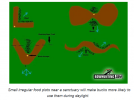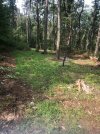There's a lot of variables to consider in your questions. Are you talking small, hidey hole plots...or large destination plots? For small hidey hole plots I prefer lots of inside and outside edge as opposed to big rectangles. Big rectangles are much easier to cultivate and move around with a tractor or ATV. But for small plots it's not a big deal to have irregular shaped plots. I do not think deer have any preference for the shape of plots...hourglass, boomerang, etc.
Connecting plots with trails...for the deer to use or for you to use? If the former, yes a small trail will facilitate the movement of deer from plot to plot if that is your goal. A bulldozer would be overkill. Or, just give it a year or 2 and the deer will make their own trail...then hunt that.
Narrowest and widest...again, that goes back to small hidey hole plots vs. destination plots. I don't have an answer for widest as I don't have large destination plots. Mine are all small hidey hole. I like narrow plots so the deer will be in bow range...but narrow comes at a cost of less light hitting the plot unless you do some serious thinning on the southern edges.


